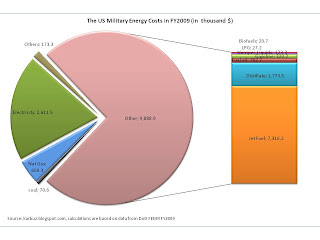The Department of Defense
Federal Energy Management Report for Fiscal Year 2009 is finally released. Although the report has May 2010 date on its cover page, it was put online in June.
Here are some important parts from the report:
“At the end of FY 2009 [September 2009], DoD was managing 1.93 billion square feet of facility space (EO 13423 defined goal-subject facilities) and had spent $3.6 billion on facility energy. In addition, DoD spent $9.6 billion on fuel for vehicles (non-fleet and fleet) and other equipment.
…..
In FY2009, 3.6 percent of DoD’s electrical consumption came from renewable sources…..the Navy operates the world’s largest wind/diesel hybrid plant at Naval Station, Guantanamo Bay, and two of the largest federal photovoltaic systems in the United States at Navy Base, San Diego, and Marine Corps Air Ground Combat Center, Twenty-nine Palms, California.
……
The DoD Net Zero Energy Installation Initiative is an effort to increase the energy independence of installations by offsetting total annual energy use through on-site energy production. The Army goals for this initiative are for five Army installations to be net zero by 2020, 25 installations by 2030, and all Army installations by 2058.
……
DoD has identified 37,493 buildings requiring either standard or advanced metering….. the total number of metered buildings in DoD is 23,674, or 63 percent of all identified buildings in FY 2009.
…….
DoD military departments and components follow the DOE facilities exclusion criterion that includes “National Security Function.” For DoD standardization purposes, the National Security Function is defined as those functions that are tied directly to war fighting, training, or operations function. These functions will generally have high energy consumption with minimal square footage and a limited ability to reduce energy consumption. Examples include, but are not limited to simulators, cold iron ships, facilities providing 24/7 logistics or maintenance support directly for enduring operations.”
There are over 200 pages in the report. BUT nowhere it gives you a full picture. I mean you cannot find a sentence that summarizes all, like how much energy did the DoD consume and at what cost? What is the total oil consumption? What is the magnitude of CO2 emissions? Etc.
Well, let me do it, again.
In FY2009 the DOD consumed 932 trillion Btu of site delivered energy (final or end use energy consumption) at a cost of 13.3 billion dollars, and emitted 73 million tons of CO2 equivalent. In terms of primary energy DoD’s consumption was 1182 billion Btu.
Over 75% of the DoD’s energy consumption and costs was for mobility (tactical and non-tactical vehicles) in 2009.
All the efforts for almost all renewable energy sources indeed target electricity which accounts for 10% of total energy consumption.
NOTE that these amounts SHOULD not be understood as the total US military energy consumption (or DOD). BECAUSE the DoD excludes energy consumed at numerous military family housing communities that are privatized, and outsourced transport services. The privatized housing community utility systems belong to the housing contractor who pays the cost of the utilities. If those housing or transport services were not privatized or outsourced, the DoD would have paid for the energy consumed, and it would have been counted in the DoD’s energy consumption, No?
And here is the most impornat part: DoD oil consumption in 2009 jumped to 375,000 barrels per day. In the year 2000 it was less than 280,000 barrels per day. Note that there are only 33 countries in the world that consume more oil than the DoD.





0 Comments:
Post a Comment
<< Home